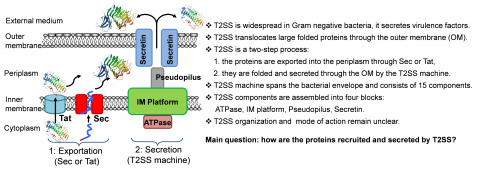Virulence factors and mechanisms

New virulence factors & Dickeya secretome
Recent T2SS secretomes of some pathogenic Proteobacteria revealed a large spectrum of functionally different exoproteins involved in virulence. Yet the full set of exoproteins secreted by the T2SS of Dickeya remains to be identified and our recent study (Liu et al. 2019) showed that these proteins could have a broad spectrum of action. To define the full set of T2SS substrates, the secretome of wild-type strains and its non-secretory mutants grown in plant-mimicking conditions will be compared. This analysis will focus on different Dickeya specie including D. solani, an important plant pathogen emerging in Europe. This will allow us to define the “core T2SS-secretome” and of the “variant T2SS-secretome” in the Dickeya genus. While the core secretome contains the general functions necessary for plant soft-rot, the accessory or unique T2SS substrates could be more recently acquired by Dickeya to conquer new niches or hosts. The quantitative proteome analysis are carried out in IBCP (Lyon) MS facility. In another, more direct approach, novel T2SS secreted proteins are systematically searched among the proteins highly induced in plant infection (RNAseq data). The proteins of unknown function carrying the signal peptide (mandatory for T2SS) are a preferred target for such analysis. The function, regulation and role in the virulence of these novel T2SS substrates will be studied as well as their occurrence in other plant pathogens. A new Fe-carrier IbpS protein has recently been identified by this approach (Liu et al., 2019). Implication: G. Condemine, E. Gueguen, N. Cotte-Pattat.
Defining a common core of plant colonization factors
Our recent studies showed a broad presence of various Dickeya species in various environments such as soil, healthy plants or water (Hugouvieux-Cotte-Pattat et al, 2019). These bacteria represent a potential source of disease outbreak, yet nothing is known on how environmental reservoirs weight on their survival, multiplication and pathogeny. To investigate genetic determinants of bacterial lifestyle both in planta and in freshwater, a major vector of pathogen dissemination through the river and irrigation networks, we will use Tn-Seq, an innovative mutagenesis combined to high throughput sequencing technique, recently implemented in the lab (Royet et al., 2019). This comparative study (ANR project TNPHYTO, starting in 2019) will make it possible to define a common core of factors essential for plant colonization and those specific to some species. Implication: G. Condemine and E. Gueguen.

